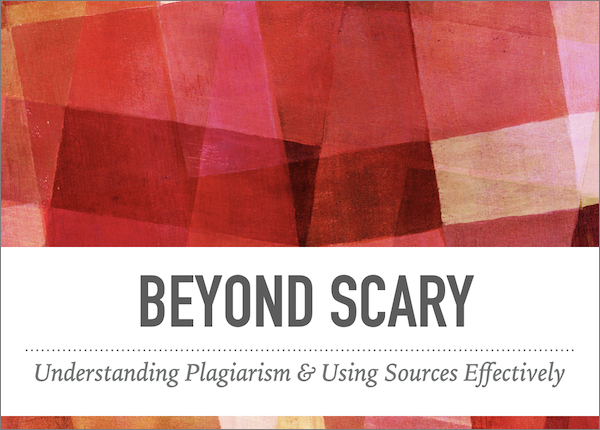Main Content
Topic Overview
Preventing Plagiarism
Definitions and Best Practices
In an academic setting, plagiarism refers to instances in which a writer deliberately uses someone else’s language, ideas, or other original material without crediting the source.
However, as Dr. Rubén Casas observes, "most concern over plagiarism fails to distinguish between the deliberate misuse of others’ ideas and word, and an inability to properly or adequately attribute ideas and words borrowed from a source:
Re-Framing and Re-Thinking Plagiarism
Rebecca Moore Howard is a prominent educator in considering how to re-frame and re-think plagiarism beyond surveillance, detection and control. Some important articles to get you started:
- Howard, R. M. (2000). The ethics of plagiarism. The ethics of writing instruction: Issues in theory and practice, 4, 79-89.
- A Plagiarism Pentimento (Rebecca Moore Howard)
- Howard, R. M., & Davies, L. J. (2009). Plagiarism in the Internet age. Educational Leadership, 66(6), 64-67.
- Howard, R. M. (1995). Plagiarisms, authorships, and the academic death penalty. College English, 57(7), 788-806.
- Howard, R. M. (2001). Forget about policing plagiarism: Just teach. The Chronicle, 11(16), 1-4.
Expand Your Knowledge
Technological Approaches to Plagiarism Prevention
In addition to re-framing the entire conversation around, and approach to, plagiarism, plagiarism detection software can be used to recognize plagiarism. Considering what you have read so far, it would be sensible to, if you choose to use it at all, that you position plagiarism software as a tool to recognize where conversation and remediation is needed rather than as a final step to judge a student's integrity.
Plagiarism Detection Software
Plagiarism detection software detects plagiarism by comparing a learner's work against a database of other learners' work and against a search of internet sources. If the work submitted by a learner has passages that match writing in the database or web sources, the software will flag the similarity in a report to the instructor and learner.
The University of Washington is transitioning to SimCheck, a plagiarism detection tool. The Faculty Council on Academic Standards and Faculty Council on Teaching and Learning guidelines require that faculty "notify their students in advance that they may be using a plagiarism detection service."
In addition, UW IT notes that "Instructors may not submit papers prepared by UW students to other Internet services to evaluate plagiarism. Plagiarism detection should be conducted only through services that have an approved contractual relationship with the UW."
In Canvas, SimCheck can be enabled on any assignment that involves submitting text or a document. See the How to Use SimCheck (Formally Vericite) Plagiarism Detection page for more directions.
Concerns About Anti-Plagiarism Software
University administrators and faculty are increasingly concerned about the impact anti-cheating software and services have on learners' data privacy. Many anti-plagiarism tools use learner data and learner-generated essays without clear consent from the learners themselves, raising questions about data privacy and intellectual property. Additionally, some researchers wonder whether the facial recognition/comparison and behavioral tracking used by some educational technologies are contributing to the rise of a culture of surveillance in higher education.
Additionally, anti-cheating software isn't free. Proctoring services raise the cost of instruction.
Finally, anti-cheating software also can seemingly raise the stakes of an assignment, exacerbating one of the mindsets that prompts learners to cheat in the first place.
Please, choose proctoring or anti-plagiarism software with great care.
Applying Key Concepts
Understanding Cheating
Before trying to address cheating and plagiarism, it's important to understand the problem. First, and most importantly:
There is no conclusive evidence that students cheat more in online or hybrid courses than they do in traditional classes.
The fear of cheating in online courses is, nonetheless, higher.
Why Do Students Cheat?
In their training materials, UW Bothell faculty and staff point out the most important reasons:
Extrinsic Motivation. If learners are motivated to learn primarily through rewards, grades, or external approval (e.g., parents, instructors, or admissions committees), cheating is more likely. Fear of not impressing others or not getting a good job can make the stakes seem disproportionately high. If learners feel pressured to be perfect, they may resort to cheating.
Lack of relevance. If a learner cannot see the relevance of a particular assignment, they may justify cheating, particularly if they feel overwhelmed by other responsibilities.
The Rochester Institute of Technology summarizes (Links to an external site.) the other most common reasons:
- Desire to get a good grade
- Fear of failing
- Procrastination or poor time management
- Disinterest in the assignment
- Belief they will not get caught
- Confusion about what constitutes plagiarism or current university policies
How to Prevent Cheating
There are two fundamental approaches to preventing cheating: pedagogical (through instructional design) and technological (through surveillance and control). Let's consider both.
Explore More! Additional Research and Resources
For Your Students
A presentation for students by Kelvin Keown, an English Learner Specialist with the UWT Teaching and Learning Center:

See also: Takeaways from Kelvin’s presentation on (teaching about) plagiarism
More UWT Resources
Defining and Avoiding Plagiarism: The WPA Statement on Best Practices
